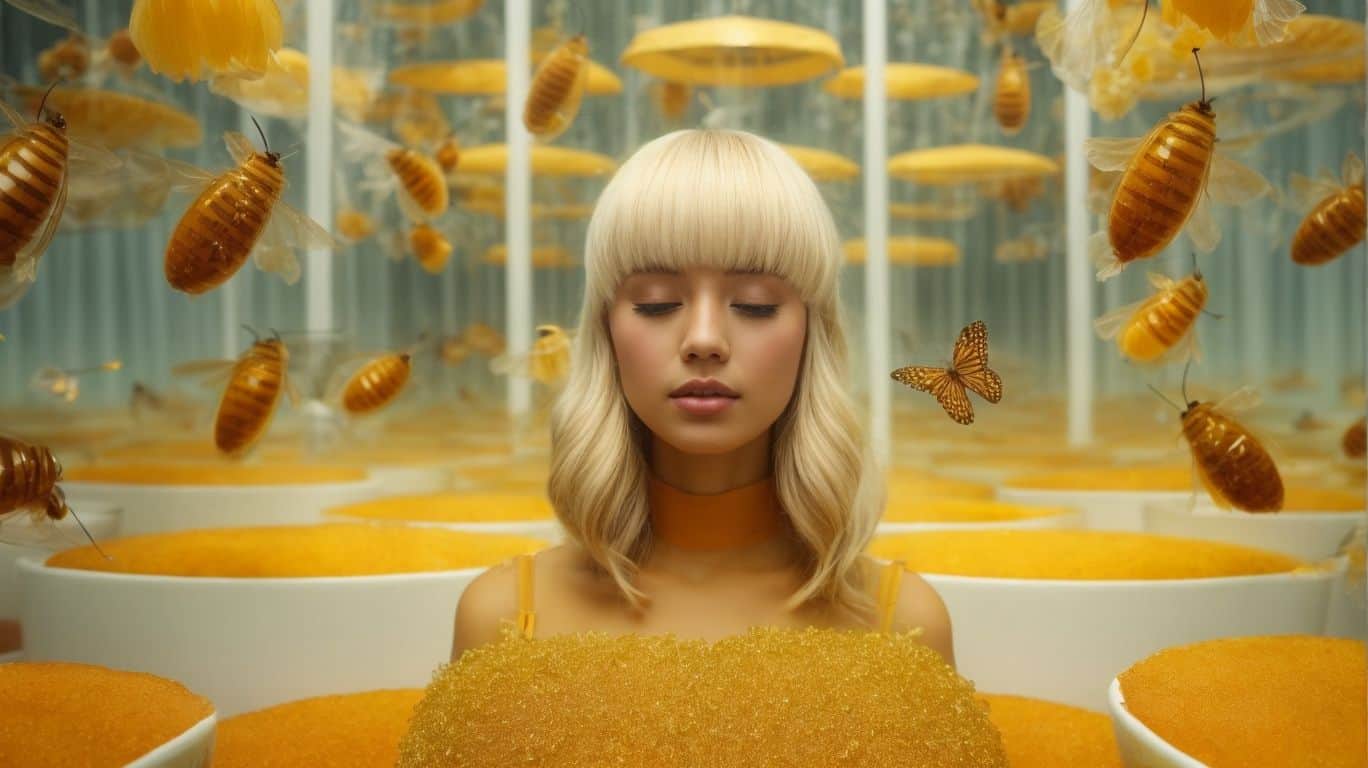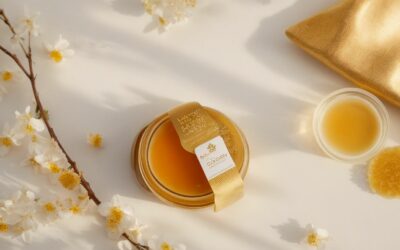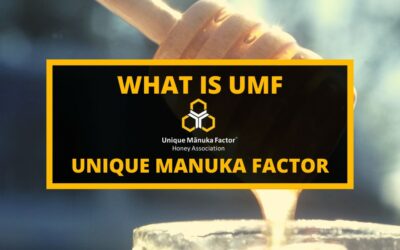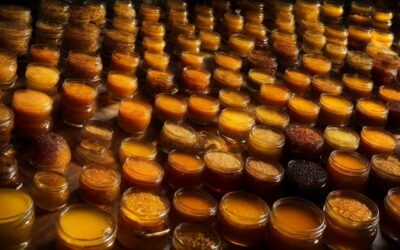Curious about the honey you’ve been consuming? Did you know that not all honey is created equal?
In fact, there’s a growing concern about the prevalence of counterfeit honey in the market. But don’t worry, I’ve got you covered. In this article, you’ll learn all about fake honey and how to spot it.
What Is Fake Honey?
Fake honey is a term used to describe honey that has been altered or counterfeited and is not produced by bees. This type of honey is often created by mixing pure honey with sugar syrup or other additives.
Unfortunately, fake honey does not offer the same nutrients and health benefits as real honey and may even contain harmful substances.
To identify fake honey, watch for signs such as a consistent texture, overly sweet taste, and lack of crystallization.
A simple water test can also be conducted to determine its purity. Choosing reputable brands or purchasing from local beekeepers is recommended to ensure you are consuming authentic and high-quality honey.
How Is Fake Honey Made?
Creating fake honey involves several steps that imitate the production of genuine honey. These include:
- Adding sugar syrup: Dilute sugar and water to create a syrup that resembles honey.
- Mixing with real honey: Combine the sugar syrup with a small amount of real honey to give it a more authentic flavor and aroma.
- Adding color: To mimic the natural color of honey, artificial colorings like caramel or food dyes are mixed in.
- Adding flavor: Artificial flavors may be incorporated to enhance the taste and aroma of the fake honey.
- Processing: The mixture is heated and filtered to remove impurities.
- Packaging: The fake honey is then packaged and labeled to appear like genuine honey.
By following these steps, counterfeit honey is produced, deceiving consumers into purchasing an inferior and adulterated product.
What Are The Signs Of Fake Honey?
As consumers, it is important to be aware of the signs of fake honey in order to make informed purchases. In this section, we will discuss the key indicators that can help you identify counterfeit honey.
From the absence of pollen to the lack of antioxidants, we will examine the various factors that can reveal the true nature of honey and distinguish it from fake substitutes. So, let’s dive into the world of fake honey and learn how to spot the signs.
1. No Pollen
One sign of fake honey is the absence of pollen, which is naturally present in real honey.
- Inspect visually: Real honey will contain visible particles of pollen.
- Perform a water test: When a spoonful of honey is added to water, real honey will settle at the bottom, while fake honey will dissolve or form a cloudy mixture.
- Read the label: Look for statements like “100% pure honey” or “raw honey” to ensure authenticity.
- Buy from reputable sources: Purchase honey from trusted brands or local beekeepers.
In a similar vein, a friend once bought honey from a street vendor but later discovered that it was counterfeit. The lack of pollen was a clear indication of its falseness.
2. No Sticky Mess
When it comes to identifying fake honey, one of the signs to look for is the absence of a sticky mess. Genuine honey has a thick and sticky texture, while fake honey tends to be less viscous and more watery.
Here are some steps to help you determine if the honey is real or fake:
- Observe the consistency of the honey – real honey should be sticky and not runny.
- Check for any unusual separation or layering in the honey.
- Inspect the honey for any added corn syrup or other sweeteners.
- Pay attention to the aroma and taste of the honey – real honey has a distinct and pleasant flavor.
By following these steps, you can avoid buying fake honey and ensure that you are consuming a genuine and high-quality product.
3. No Antioxidants
When it comes to identifying fake honey, the absence of antioxidants is one of the key signs to watch out for. Here are some steps to help you determine if the honey you have lacks these important compounds:
- Check the label for any information about antioxidants or their presence in the honey.
- Perform a taste test – real honey often has a rich, complex flavor due to the presence of antioxidants.
- Observe the color of the honey – antioxidants contribute to its darker hue, so if it appears lighter, it may not have enough antioxidants.
- Consider the source – honey from reputable brands or local beekeepers is more likely to contain antioxidants.
Antioxidants play a crucial role in protecting our bodies from oxidative stress and promoting overall health. They help combat free radicals and reduce the risk of chronic diseases. Therefore, it’s important to choose honey that contains these beneficial compounds.
4. No Crystallization
Crystallization is a natural process that occurs in real honey over time. If your honey does not crystallize, it may be a sign of fake honey. Here are steps to determine if your honey has crystallized:
- Check the texture: Real honey will have a thick, creamy texture when it crystallizes.
- Look for granules: Crystallized honey will have visible sugar crystals in the jar.
- Observe the color: Crystallized honey may appear lighter or have a cloudy appearance.
- Test with a spoon: Dip a spoon into the honey and slowly turn it upside down. If the honey sticks and slowly drips, it is likely crystallized.
Remember, purchasing from reputable sources and reading labels can also help you avoid fake honey and ensure you are getting a genuine product.
5. No Honeycomb
When trying to identify fake honey, the absence of honeycomb is a clear indication. Honeycomb is a natural component of authentic honey, as it is created by bees to store their honey. To determine whether honey contains honeycomb, follow these steps:
- Inspect the jar: Look for small pieces of honeycomb suspended in the honey.
- Check the texture: Real honey may have small, soft pieces of honeycomb that can be easily crushed.
- Observe the color: Honeycomb can give the honey a golden or amber hue.
True story: A beekeeper once discovered that the honey they purchased did not contain any honeycomb. This discovery prompted them to investigate the honey’s authenticity, leading to the exposure of a counterfeit honey operation in their area.
By paying attention to the presence of honeycomb, they were able to avoid buying fake honey in the future.
Why Is Fake Honey Produced?
The production of fake honey is a growing issue in the global market. But why do some producers resort to creating counterfeit honey? In this section, we will uncover the reasons behind this deceitful practice.
From meeting high demand to avoiding import taxes, the motivations behind producing fake honey are diverse. By understanding these reasons, we can better protect ourselves from purchasing fraudulent honey and support ethical and authentic honey producers.
1. To Meet High Demand
To meet high demand, producers may resort to producing counterfeit honey. To avoid buying fake honey, follow these steps:
- Buy from reputable sources: Purchase honey from trusted sellers or local beekeepers to ensure authenticity.
- Read labels carefully: Look for information about the country of origin, ingredients, and any certifications or quality seals.
- Do your research: Learn about the different brands and types of honey available in the market to make informed choices.
By taking these precautions, you can protect yourself from purchasing fake honey and enjoy the benefits of real, high-quality honey.
2. To Make More Profit
Making a larger profit is one of the main motivations behind the production of fake honey. To avoid purchasing these counterfeit products and to support genuine producers, here are some steps you can take:
- Purchase from reputable sources, such as local beekeepers or trusted brands, to ensure the authenticity of the honey.
- Carefully read labels, paying attention to the country of origin and any certifications or quality seals listed.
- Educate yourself about the characteristics and qualities of real honey so that you can easily identify and avoid fake products.
3. To Avoid Import Taxes
To avoid import taxes, producers of fake honey employ various tactics. Here are some steps to consider when trying to avoid buying counterfeit honey:
- Buy from reputable sources: Choose trusted suppliers and brands with a track record of quality assurance.
- Read labels carefully: Look for information on the country of origin, certifications, and ingredients.
- Do your research: Educate yourself about counterfeit honey and learn about common signs of fake honey.
By following these steps, you can reduce the risk of purchasing fake honey and ensure that you are getting a genuine, high-quality product.
How To Identify Real Honey?
With the rise of counterfeit honey in the market, it is becoming increasingly important to know how to identify real honey. In this section, we will discuss four key ways to determine the authenticity of your honey.
From checking the country of origin to reading the ingredients, these methods will help you make sure that the honey you are consuming is pure and not a fake product.
Let’s dive into these techniques and learn how to spot the difference between real honey and counterfeit honey.
1. Look For The Country Of Origin
When purchasing honey, it is crucial to check for the country of origin to ensure its authenticity and quality. Here are steps to help you identify the country of origin:
- Check the label: Look for information on the label about the country where the honey was produced.
- Research honey standards: Different countries have their own regulations and standards for honey production. It is important to familiarize yourself with these standards to know what to expect.
- Know the characteristics of the honey: Certain countries are known for producing specific types of honey. For example, Manuka honey is primarily produced in New Zealand.
- Support local producers: Buying honey from local beekeepers increases the likelihood of getting genuine honey from your country.
2. Check The Label
Checking the label is an important step in identifying real honey. Here are a few steps to follow when checking the label:
- Look for the country of origin: Genuine honey will clearly state the country where it was produced. Some countries have strict regulations for honey production.
- Check the label: Look for specific information such as the name of the company or brand, address, contact details, and certifications. The best Manuka honey that is genuine will have proper labeling.
- Do the water test: Place a drop of honey in water. If it dissolves or spreads quickly, it may indicate the presence of additives. Real honey will stay intact.
- Read the ingredients: Check the list of ingredients. Pure honey should have only one ingredient – honey.
3. Do The Water Test
To determine if honey is fake, you can perform a simple water test. Here are the steps to do the water test for honey authenticity:
- Fill a glass with water.
- Add a tablespoon of honey to the glass.
- Observe the honey’s behavior in the water.
- If the honey dissolves instantly or forms a thin layer at the bottom, it may be fake.
- Authentic honey will settle at the bottom in a clump or form a slow-moving, diffusing clump.
- Finally, perform the water test to determine the authenticity of the honey.
4. Read The Ingredients
When examining the ingredients of honey, be sure to follow these steps to ensure authenticity:
- Look for a single ingredient: honey. Avoid products with additional additives or sweeteners.
- Check for specific floral sources: authentic honey may specify the type of flowers the bees collected nectar from.
- Inspect for any artificial flavorings or colorings: real honey should not have any added flavors or colors.
- Read the label for any additional ingredients or processing methods that may indicate it is not pure honey.
Remember, reading the ingredients is crucial to identify genuine honey and avoid counterfeit products.
Fact: Some counterfeit honey contains illegal antibiotics and harmful chemicals.
What Are The Health Risks Of Consuming Fake Honey?
Fake honey, also known as adulterated honey, has become a major concern in the food industry. This counterfeit version of honey is created by adding various additives and chemicals to mimic the appearance and taste of real honey.
However, consuming fake honey can have serious health risks. In this section, we will discuss the potential dangers of consuming fake honey, including harmful additives, allergic reactions, and traces of antibiotics and pesticides.
We will also examine how fake honey lacks the nutritional benefits of real honey and the impact it can have on our overall health.
1. Contains Harmful Additives
Consuming counterfeit honey can be dangerous as it may contain harmful additives that can negatively impact one’s health. To ensure the purchase of authentic honey, follow these steps:
- Purchase from reputable sources known for selling genuine honey.
- Carefully read labels and look for certifications or quality seals that indicate the honey is authentic.
- Conduct research and educate yourself on counterfeit honey to recognize common signs and techniques used to produce fake honey.
Fact: Real, high-quality honey has numerous health benefits, including providing antioxidants, soothing coughs, and aiding in wound healing.
2. Can Cause Allergic Reactions
Consuming counterfeit honey can result in allergic reactions for certain individuals. This is because fake honey often contains additives, such as corn syrup or artificial sweeteners, that can trigger allergic responses.
Furthermore, fake honey may also be contaminated with antibiotics or pesticides, which can lead to adverse reactions.
It is crucial to exercise caution when buying honey and choose reputable sources. Reading labels carefully and conducting research can aid in identifying authentic honey and preventing potential health risks.
3. May Contain Antibiotics And Pesticides
Consuming counterfeit honey can pose significant risks to one’s health as it may contain antibiotics and pesticides.
These harmful substances can have negative impacts on the body, potentially causing allergic reactions or the ingestion of harmful additives.
Furthermore, fake honey lacks the nutritional benefits found in authentic honey.
To avoid purchasing fake honey, it is crucial to buy from trustworthy sources, carefully read labels, and conduct thorough research to ensure the product’s authenticity.
By taking these precautions, consumers can protect their health and enjoy the numerous benefits offered by genuine, unadulterated honey.
4. Lacks Nutritional Benefits
Fake honey lacks the nutritional benefits found in real honey due to the processing methods used to produce it. The heating and filtering process of fake honey strips it of its natural enzymes, antioxidants, and other beneficial compounds.
In contrast, real honey retains these important nutritional components. Consuming fake honey means missing out on potential health benefits, such as its antibacterial and anti-inflammatory properties.
To ensure you are consuming real, nutritious honey, it is important to purchase from reputable sources, carefully read labels, and do thorough research on counterfeit honey.
By taking these precautions, you can avoid buying fake honey and enjoy all the nutritional benefits of the real thing.
How To Avoid Buying Fake Honey?
With the increasing prevalence of counterfeit honey in the market, it is important to know how to avoid falling victim to this fraudulent product. In this section, we will discuss three important strategies for avoiding buying fake honey.
These include purchasing from reputable sources, reading labels carefully, and conducting thorough research on the product and its origins. By following these tips, you can ensure that you are purchasing high-quality, authentic honey.
1. Buy From Reputable Sources
When it comes to purchasing honey, it is crucial to buy from trustworthy sources to ensure its authenticity and quality. Here are some steps to follow:
- Do Your Research: Look for reputable brands or local beekeepers with a good track record. Get it on Amazon.com or New Zealand Honey Co.
- Read Reviews: Check online reviews or ask for recommendations from friends or family.
- Check for Certifications: Look for certifications such as USDA Organic or Fair Trade, which indicate a higher level of quality and ethical production.
- Visit Farmers Markets: Purchasing honey directly from beekeepers at farmers markets allows you to ask questions and learn more about their practices.
- Read Labels: Look for clear and transparent labeling, including information about the source, ingredients, and processing methods.
2. Read Labels Carefully
When it comes to purchasing honey, it’s crucial to carefully read labels to ensure that you are getting the real deal. Follow these steps to make sure you are buying authentic honey:
- Check for the country of origin: Look for honey that specifies the country where it was produced. Some countries have stricter regulations and standards for honey production.
- Inspect the label: Look for information such as the producer’s name and address, batch number, and any certifications or quality seals. These can indicate authenticity and quality.
- Do the water test: Place a drop of honey in water. If it dissolves quickly or spreads, it may contain added water or other substances.
- Read the ingredients: Authentic honey should have one ingredient: honey. Avoid products with added sugars, artificial flavorings, or other additives.
True story: A friend of mine once made the mistake of purchasing honey without carefully reading the label. It turned out to be a fake product, lacking the natural sweetness and health benefits of authentic honey.
Since then, she always takes the time to read labels and ensure she’s buying the real thing.
3. Do Your Research
Doing your research is crucial when it comes to identifying and avoiding fake honey. Here are steps you can take to ensure you’re purchasing real honey:
- Look for the country of origin – Choose honey that clearly states where it was produced.
- Check the label – Look for certifications or quality seals from reputable organizations.
- Do the water test – Real honey will not easily dissolve in water, while fake honey may dissolve or leave residue.
- Read the ingredients – Pure honey should have only one ingredient: honey.
- Follow these steps and conduct thorough research to protect yourself from buying counterfeit honey.
Frequently Asked Questions
What is fake honey?
Fake honey refers to honey that has been adulterated with other substances or is made from ingredients other than pure honey. It is often produced in large quantities and sold at a lower price than real honey.
How can I identify fake honey?
There are several ways to identify fake honey, including checking the label for the source of the honey, its ingredients, and any certifications. You can also perform a simple home test, such as the water test, to see if the honey is pure or fake.
Why is fake honey harmful?
Fake honey can be harmful because it is often made from low-quality ingredients, such as high-fructose corn syrup and other additives. Consuming fake honey can also lead to health issues, as it may be contaminated with antibiotics, heavy metals, and other harmful substances.
How does fake honey affect the honey industry?
Fake honey not only harms consumers but also has a negative impact on the honey industry. It creates unfair competition for genuine honey producers and can result in a decline in their sales and profits.
Can fake honey be sold legally?
No, it is illegal to sell fake honey. In most countries, honey is subject to strict regulations, and selling fake honey can result in penalties and legal consequences for the producer or seller.
How can I support the production and sale of real honey?
To support the production and sale of real honey, always purchase honey from trusted sources that provide information about the honey’s source and production process. You can also look for certifications, such as the USDA Organic label, to ensure that the honey is genuine.
I’m a Manuka honey enthusiast and creator of Manuka Honey Organic, a blog where I share my journey with authentic Manuka honey from New Zealand. I want everyone to learn about the healing powers of Manuka honey.





